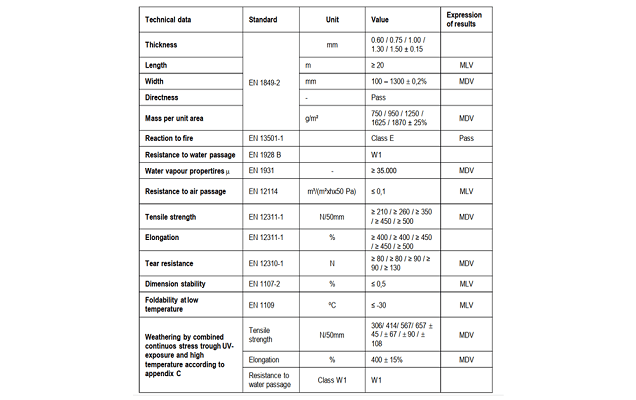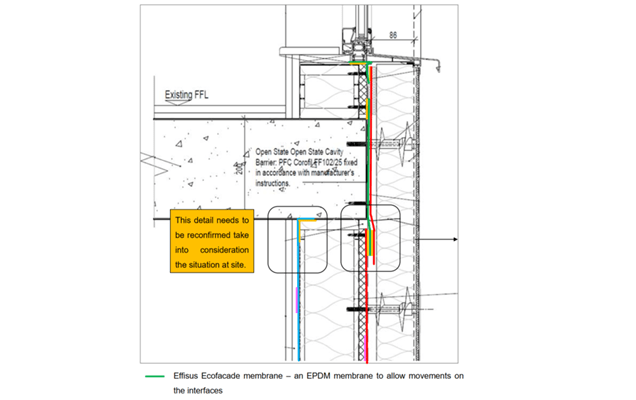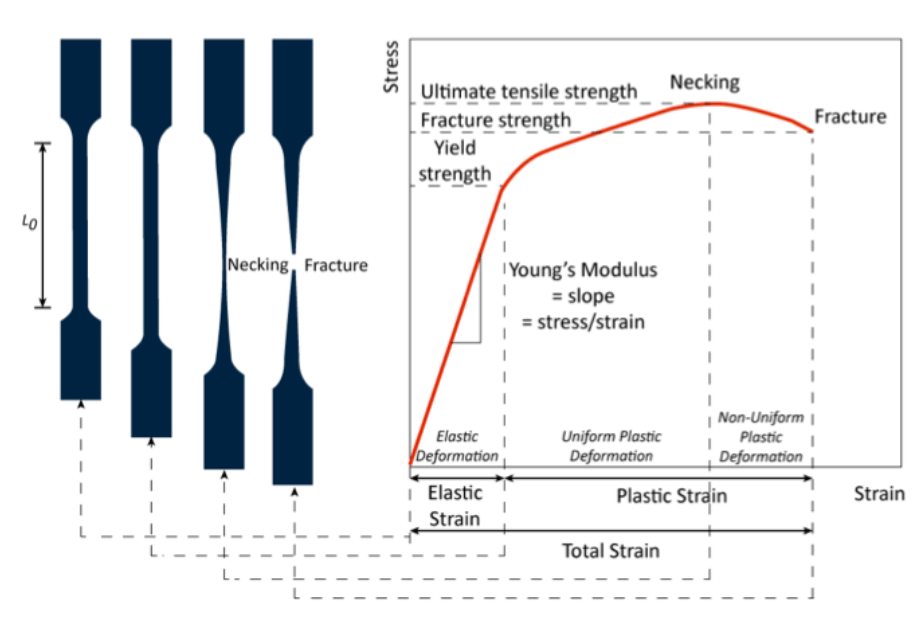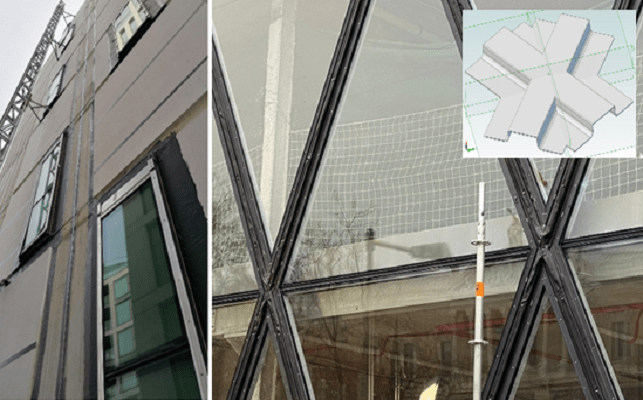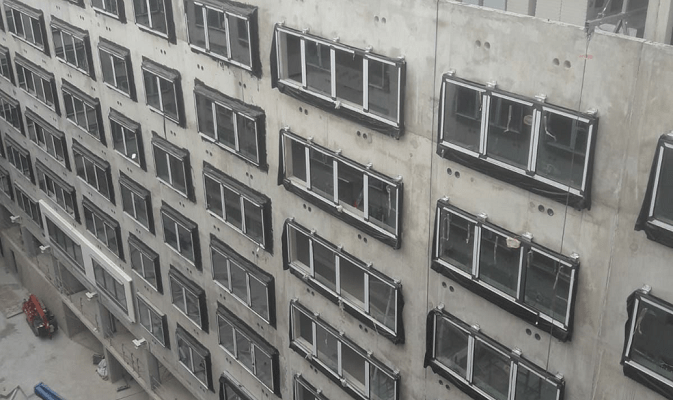
EPDM in Facades
Nowadays facade projects are becoming more and more demanding and are constantly pushing the boundaries. Currently, the façade design is challenged to deliver a unique aesthetic façade (curved, twisted, transparent, etc.) and energy-efficient to fit into an inflexible budget/schedule. In most cases, this is a great challenge. Unique aesthetics turn sealing interfaces/construction joints an even harder task. Understanding that seals are crucial at interfaces between elements such as, glazing/wall sheathing board, wall sheathing board/concrete slab (or similar), parapet/roofing connection, GF connections, Curtain wall typology and many other examples is of the most importance. Such joints are particularly vulnerable to water and air leakage along with differential movements and it is vital that a robust, durable and efficient seal is applied.
This solution ensures water, vapour and airtightness to all facade element connections protecting the building and maximizing energy efficiency.
It is reliable to say that applying EPDM in facades brings the following benefits:
- Robustness: Water, Air and Vapour tight solution with elongation > 400%
- Durability – It has a high life-expectancy even with UV total exposure
- Predictability – It allows for bespoke shapes and dimensions allowing to transfer tasks from site to the Factory where there’s a controlled environment (better weather conditions, quality workmanship, improved work conditions);
- Universal – It is a solution used worldwide in different and extreme weather conditions;
- Efficiency – Integrated self-adhesive bands and/or fast-connect clip-in gasket possibilities which improves the quality and speed of application while narrowing the possibilities of human errors;
In facade projects, this membrane is used on the following applications:
- Connections on ventilated facades typology;
- Connections on curtain walls typology;
- Connections on modular and off-site construction;
- Sustainable Construction Projects.
CE Marking
It is important to notice that the Construction Products Regulation requires that every product is covered by harmonized European standards or conform to European Technical Assessments, and should normally have CE marking – Approved Document 7.
Materials like EPDM should comply to the standard BS EN 13859-2 entitled “Flexible sheets for waterproofing. Definitions and characteristics of underlays. Underlays for walls”.
Important consideration should be given to following properties:
- Resistance to Water Penetration – BS EN 1928:2000 entitled “Flexible sheets for waterproofing. Bitumen, plastic and rubber sheets for roof waterproofing”. Determination of watertightness.
- Water Vapour Transmission Properties – BS EN 1931:2000 entitled “Flexible sheets for waterproofing. Bitumen, plastic and rubber sheets for roof waterproofing”. Determination of water vapour transmission properties.
- Resistance to Air Permeability – BS EN 12114:2000 entitled “Thermal performance of buildings. Air permeability of building components and building elements. Laboratory test mehods”.
- Tensile Strength and Elongation – EN 12311-1:2000 entitled “Flexible sheets for waterproofing. Determination of tensile properties. Bitumen sheets for roof waterproofing”.
Technical Requirements
EPDM membranes are combustible, class E as per the BS EN13501-1:2018 entitled “Fire classification of construction products and building elements. Classification using data from reaction to fire tests”.
Because of that, extreme careful consideration must be given to their use.
Consulting The Building (Amendment) Regulations 2018, at paragraph (2), it states that building work shall be carried out so that materials which become part of an external wall, or specified attachment, of a relevant building are of European Classification A2-s1, d0 or A1, classified in accordance with BS EN 13501-1.
However, looking at paragraph (3), a list of exemptions is present and includes the following items: seals, gaskets, fixings, sealants and backer rods.
CWCT/SFE issued recently an important and reliable clarification to the façade community through the Technical guidance for interpretation in relation to the external walls and specified attachments of Relevant Buildings in England (published in September 2020). They consider ‘Seals’ and ‘Sealants’ included but are not limited to
- Wet applied sealants, used for example at interfaces between elements, at movement joints, panel joints;
- Tapes, used for example to seal joints in sheathing boards and membranes;
- Impregnated foam tapes, used for example at window perimeter seals and movement joints;
- Bonded glazing/structural sealant glazing application.
CWCT states that the sealing of joints between sheathing boards on a framed back wall is of the most importance to limit air leakage and to provide a water barrier within the wall construction.
As non-combustible sealing tapes are not available in the market, strips of membrane may be used to seal these joints. If the membrane has a width of less than 150mm and is protected behind non-combustible insulation, then the membrane is exempt from Regulation 7 (2).
By imposing the previous conditions, the use of a membrane in this location is considered of controlled risk of fire spread.
Seals in interfaces are not exposed; typically, they are fixed between a window and the back wall and covered with non-combustible insulation, or between a curtain wall profile and the surrounding wall by a non-combustible dry lining system.
R&D
Several class B (BS EN 13501-1) fire-rated membranes are now on the market, but they lack the ability to accommodate differential movements on joints/interfaces generally between 5 to 25mm. This property is measured by Elongation/Tensile Strength (BS EN 12311-1) on longitudinal and transverse direction, before and after ageing as per BS EN 13859-2.
It is crucial to understand the meaning of Elongation. It measures the materials’ ductility. This measurement shows how much a material can be stretched, as a percentage of its original dimensions, before it breaks. It indicates the ability of a material to undergo significant deformation before failure.
Materials with a higher elongation at break percentage have higher ductility.
High ductility indicates that a material will be more likely to deform and not break, whereas low ductility indicates that a material is brittle and will fracture before deforming much under a tensile load.
EPDM membrane is a weatherproofing membrane (water, air and vapour control) that has an elongation > 400% however it is Class E and flammable.
Take into consideration that a membrane that combines fire performance Class A or Class B with elongation is not available anywhere in the world and, therefore, it is duly recommendable the use of an EPDM membrane.
The current UK regulation considers this material a ‘seal’ and is exempted from regulation 7(2).
The manufacturers industry is working hard to develop solutions that fulfill all the façade technical requirements (water, air and vapour control) along with elongation and fire performance.
Conlusion
Considering the above, it is easy to understand the importance of EPDM membranes and that there’s a lack of a reliable alternative in the market today.
Until a better solution is found and complying with all current regulations as well as fulfilling all technical requirements for a façade project, EPDM is still the best available product. The membranes width should be reduced to minimize combustibility. All membranes should be protected by minimum Class A1 or A2 materials such as, membranes, mineral wool insulation, metallic sheets, or any other non-combustible material.
In conclusion all the façade parties such as Manufacturers, Architects, Façade Consultants, Building Control & Government, Building Insurers, Developers and Fire Consultants need to have a pragmatic approach and work in a project-by-project basis, detail by detail. The use of EPDM membranes is not seen as an alternative but should be mandatory.
If you want to receive more information about Effisus services or products, please subscribe our Newsletter.




